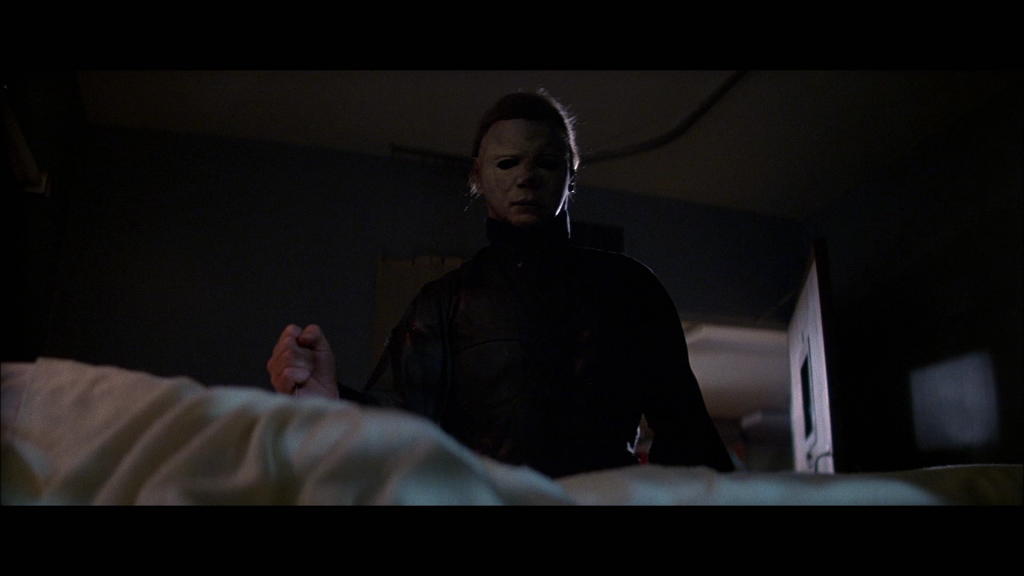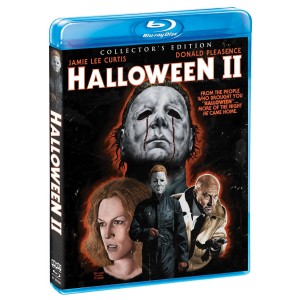
One could argue that few film franchises are more polarizing among horror fans than the HALLOWEEN series and of the installments featuring Michael Myers, it is HALLOWEEN II that is, perhaps, the most controversial. Considered by some to be a worthy follow-up to its now legendary predecessor and by others to be a steamy pile of garbage, the film’s more aggressive use of gore, its hospital set piece and its familial plot twist have left few horror devotees without a definite opinion about its creative and/or entertainment worth.
Written and produced by John Carpenter and Debra Hill, this 1981 sequel picks up just seconds after the original leaves off; a device used 50 years earlier in BRIDE OF FRANKENSTEIN. With HALLOWEEN II, the epic suburban struggle between good and evil continues on that fateful Halloween night in 1978. An injured and traumatized Laurie Strode (Jamie Lee Curtis) is rushed to the hospital, while a guilt-ridden Dr. Sam Loomis (Donald Pleasance) and a group of Haddonfield’s finest take to the streets, in a desperate attempt to apprehend the seemingly invincible killer known as Michael Myers (Dick Warlock).
Not wanting to direct the sequel himself, Carpenter offered the job to friend, HALLOWEEN editor and future HALLOWEEN III: SEASON OF THE WITCH director Tommy Lee Wallace; who turned it down due to some dissatisfaction with the script. Carpenter then, thinking a bit outside the box, selected (future HALLOWEEN: RESURRECTION director) Rick Rosenthal to lead the production; a filmmaker with (at the time) zero feature film experience and only a handful of television and student film credits to his name.
Throughout the first half of the film, Rosenthal and (returning) cinematographer Dean Cundey do a commendable job of preserving the look and feel of Carpenter’s original masterpiece, but as the narrative unfolds, the audience is slowly pulled away from the comfortable familiarity of everyday American suburbia and taken to a much darker and more frighteningly surreal place.
The film is frequently criticized for its primary set piece being an unrealistically vacant hospital, but it is the building’s emptiness that gives the film its memorable nightmarish quality. With this location, Rosenthal and Cundey take full advantage of their surroundings. Long empty corridors, hard shadows and dramatic camera angles beautifully pay homage to horror cinema’s German Expressionist roots. Cundey’s use of lavish primary colors when lighting key scenes (most notably during the basement chase) helps to inject the film with sparing tastes of “giallo” flavor.
Much has been said over the years about the friction between Rosenthal and Carpenter during the film’s post-production. Carpenter has been very vocal about his filming additional “scares” and re-cutting the film in an effort to quicken its pace, but ultimately it is Rosenthal that managed to take previously explored territory and give it its own identity. Despite his inexperience and a subpar script, Rosenthal was able to take the ideas and style of Carpenter’s iconic original film and make them his own.
Unlike its game-changing predecessor, HALLOWEEN II was released into a marketplace saturated with HALLOWEEN-inspired slasher films that were attempting to exponentially push the boundaries of violence, gore and nudity in cinema. In order to compete, the highly anticipated sequel was forced to shy away from the subtle, more suspense-driven approach of its forerunner and adopt a more graphic and, arguably, less sophisticated sensibility.
Thankfully, Rosenthal’s ability to handle the dramatic aspects of the script helps to keep the film from drifting too far into senseless slasher territory. The flirtatious romantic relationship between Laurie Strode and paramedic Jimmy (Lance Guest) is handled with surprising subtlety. Its innocence is charming and it infuses this sequel with a tenderness and depth that is absent from most films of the sub-genre—including the original HALLOWEEN. Conversely, Loomis’ guilt-driven determination is executed with such heavy-handedness, that it keeps otherwise boring (often expositional and formulaic) scenes interesting and engaging. Almost impossibly, Donald Pleasance (as Dr. Loomis) manages to deliver a performance, that is both wonderfully over the top and dramatically understated–and 100% thoroughly enjoyable to watch.
Despite the fact that it was panned by critics upon its original release, HALLOWEEN II managed to do well at the box office; “out grossing” many of its 1981 horror competitors. In more recent years, many critics have changed their “once negative” stance on the film; recognizing that it yields more value than many films of the same ilk.
Though many fans may remain split on the issue, the fact that both Universal Studios and Scream Factory (a subdivision of Shout! Factory) have recently released “collector’s editions” of the film on Blu-ray and DVD is evidence that time has served it well and that it has found a loving and loyal fan-base.
Universal Studios’ 2011 “30th Anniversary Edition” may have been a significant upgrade to all of the film’s earlier home re-releases, but with the omission of the “Moustapha Akkad Presents” opening title card, a slightly scratched and marked HD transfer and a disappointingly meager collection of HALLOWEEN II-related bonus features consisting of only a handful of deleted scenes (taken from the frequently aired television version of the film and presented in the obsolete 4:3/full frame aspect ratio), it left much to be desired. Its only saving grace was the inclusion of the fan-favorite and clip-heavy 1984 documentary about the horror genre, TERROR IN THE AISLES (hosted by Donald Pleasance & Nancy Allen).
 Thankfully the 2012 “2-Disc Collector’s Edition
Thankfully the 2012 “2-Disc Collector’s Edition” finds Scream Factory rising to the occasion, heeding the fan outcry and delivering the best HALLOWEEN II reissue to date. Loaded with extras, this latest edition includes an informative (and cast & crew packed) 45-minute documentary about the making of the film, a 13-minute featurette about the film’s various production locations, trailers, TV and radio spots, a still gallery, 8 minutes worth of deleted and alternate scenes, two very worthwhile audio commentaries featuring director Rick Rosenthal & actor Leo Rossi and stunt coordinator/The Shape Dick Warlock (respectively), a reversible slipcover with both the original and newly commissioned artwork and a 2nd disc containing the entire television version of the film (presented in the 4:3/full frame format and with a mono audio track).
As for technical specs, Scream Factory used a cleaned up and restored 1080p/AVC encode of Universal’s 30th Anniversary 2:35:1 HD transfer; giving fans a close to flawless image; rich in color, deep in its blacks and without scratches and marks. The new 5.1 DTS-HD Master Audio mix, like Universal’s, is not amazing, but perfectly satisfactory…though fans may actually find its 2.0 DTS audio mix more balanced and desirable.
With two Blu-ray editions of this fan polarizing sequel being released in only one year’s time, the HALLOWEEN series continues to prove to be what the film distribution industry calls an “evergreen” (meaning it will always make money) and though some disappointment from buyers of the Universal Studios “30th Anniversary Edition” is understandable and inevitable, true fans of the film will find the new Scream Factory HALLOWEEN II “2-Disc Collector’s Edition” totally worthwhile and an absolute “must” for their collections.

[…] sequel (for more details on that, check out my Podwits review for the Blu-ray reissue by CLICKING HERE) delivers a totally worthwhile suspenseful and stylish viewing experience, that not only lives up […]